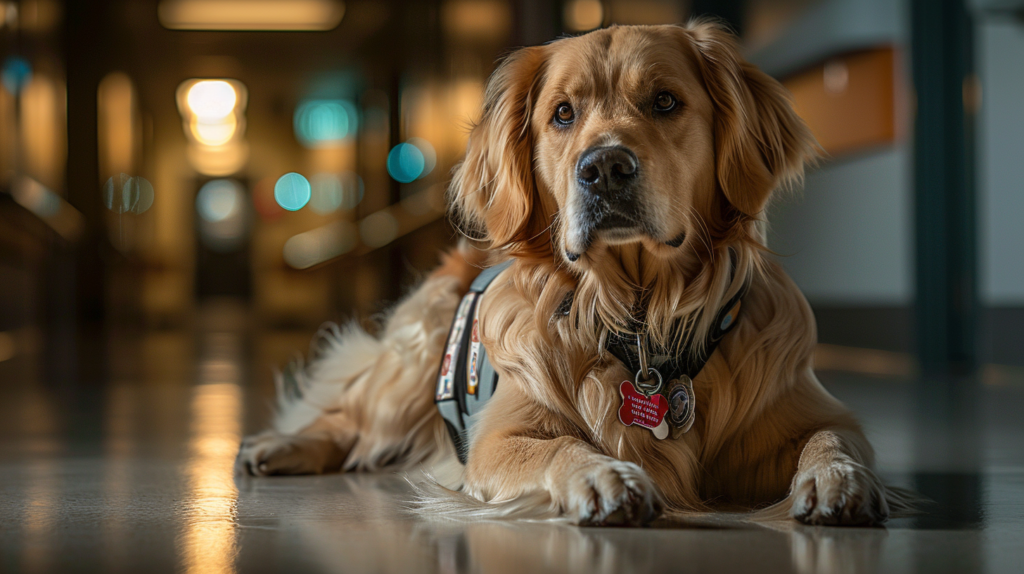Discover how American Service Pets can transform lives through 6 essential ways. Expert guide on service dog benefits, training, legal rights, and finding the right companion for your needs.
Table of Contents
Did you know that over 500,000 Americans rely on service dogs to navigate daily life with greater independence and confidence? These remarkable American Service Pets represent far more than trained companions—they’re life-changing partners that bridge the gap between disability and full participation in society.
When I first encountered a service dog team at a grocery store in Portland three years ago, I was struck by the seamless partnership between handler and dog. The golden retriever calmly retrieved dropped items, provided stability support, and even alerted to an oncoming medical episode—all while maintaining perfect public behavior. This moment opened my eyes to the incredible capabilities of American Service Pets and their profound impact on human lives.
American Service Pets are specially trained working animals that perform specific tasks for individuals with disabilities, protected under the Americans with Disabilities Act (ADA). Unlike emotional support animals or therapy pets, service animals undergo rigorous training to perform life-essential tasks that enable their handlers to live more independently and safely.
This comprehensive guide explores six fundamental ways American Service Pets can help individuals with disabilities, the legal framework protecting these partnerships, and practical guidance for those considering this life-changing relationship. Whether you’re exploring options for yourself or a loved one, understanding the full scope of service pet capabilities is crucial for making informed decisions.
What Are American Service Pets?

American Service Pets are working animals, primarily dogs, individually trained to perform specific tasks for people with disabilities. Under the ADA, service animals are defined as dogs (and in some cases miniature horses) that are individually trained to perform tasks directly related to a person’s disability.
The distinction between service animals and other assistance animals is critical. American Service Pets must:
- Be individually trained to perform specific disability-related tasks
- Provide work or perform tasks directly related to the handler’s disability
- Maintain appropriate public behavior and training standards
- Be under the control of their handler at all times
These animals undergo extensive training programs lasting 18-24 months on average, costing between $15,000 to $30,000 per animal. The investment reflects the specialized skills required and the life-changing impact these partnerships provide.
Legal Framework and Protections
The Americans with Disabilities Act provides comprehensive protections for American Service Pets and their handlers, including:
- Public Access Rights: Service animals can accompany their handlers in all public accommodations where pets are typically prohibited
- Housing Accommodations: No-pet policies cannot exclude service animals, and handlers cannot be charged pet fees
- Air Travel Protections: Service animals can travel in aircraft cabins with their handlers
- Workplace Accommodations: Reasonable accommodations must be made for service animals in employment settings
Six Essential Ways American Service Pets Can Help You
1. Physical Assistance and Mobility Support
American Service Pets trained for mobility assistance provide crucial physical support for individuals with various mobility impairments. These highly trained dogs can perform numerous tasks that enhance independence and safety.
Key Mobility Tasks Include:
- Balance and Stability Support: Dogs wear special harnesses that allow handlers to maintain balance while walking or standing
- Fall Prevention: Trained to provide bracing support when handlers feel unsteady
- Wheelchair Assistance: Opening doors, retrieving dropped items, and providing pulling assistance
- Transfer Support: Helping handlers move from wheelchairs to beds, chairs, or cars
- Navigation Assistance: Guiding handlers around obstacles and through crowded spaces
Real-World Impact: Sarah, a 34-year-old woman with multiple sclerosis, reports her mobility service dog has enabled her to return to work full-time. “Rex helps me navigate my office building, retrieves files I drop, and provides stability when my balance is compromised during flare-ups,” she explains.
Studies show that individuals using mobility service dogs experience a 60% reduction in fall-related injuries and report significantly improved confidence in public settings.
2. Medical Alert and Response Services
Medical alert American Service Pets are trained to detect subtle changes in their handler’s body chemistry or behavior that precede medical episodes. These dogs can provide life-saving early warnings and emergency response.
Medical Alert Capabilities:
- Diabetic Alert: Detecting dangerous blood sugar fluctuations through scent detection
- Cardiac Alert: Recognizing pre-cardiac episode symptoms and behaviors
- Seizure Response: Providing during and post-seizure assistance
- Allergy Detection: Identifying dangerous allergens in the environment
- PTSD Response: Interrupting nightmares, flashbacks, and anxiety episodes
Training Focus: These dogs undergo specialized scent training and behavioral recognition protocols, often working with medical samples and controlled exposure to their handler’s specific condition indicators.
Medical Response Tasks:
- Retrieving medications or medical equipment
- Activating medical alert systems
- Providing deep pressure therapy during episodes
- Guiding disoriented handlers to safe locations
- Staying with handlers during medical emergencies until help arrives
3. Psychiatric Service and Emotional Regulation
Psychiatric American Service Pets assist individuals with mental health disabilities through trained task performance that goes beyond companionship. These dogs perform specific interventions that help handlers manage symptoms and maintain daily functioning.
Psychiatric Service Tasks:
- Anxiety Intervention: Performing deep pressure therapy during panic attacks
- Medication Reminders: Alerting handlers to take prescribed medications
- Nightmare Interruption: Waking handlers from PTSD-related nightmares
- Grounding Techniques: Providing tactile stimulation during dissociative episodes
- Crowd Control: Creating physical barriers in overwhelming social situations
- Exit Strategy: Leading handlers to exits during anxiety episodes
Evidence-Based Benefits: Research published in the Journal of Rehabilitation Research shows psychiatric service dog handlers experience:
- 82% reduction in PTSD symptom severity
- 40% decrease in prescription medication dependence
- Significant improvements in social functioning and employment stability
Training Considerations: Psychiatric service dogs require extensive socialization and task-specific training, often customized to their handler’s specific triggers and needs.
4. Guide Services for Visual Impairments
Guide dogs represent one of the most recognized types of American Service Pets, providing navigation and obstacle avoidance for individuals who are blind or have low vision.
Guide Dog Capabilities:
- Obstacle Navigation: Avoiding overhead, ground-level, and moving obstacles
- Traffic Safety: Stopping at curbs and assessing traffic patterns
- Target Location: Finding specific locations like doors, stairs, elevators, and seating
- Disobedient Disobedience: Refusing commands that would put the handler in danger
- Route Memory: Learning and following regular travel routes
Intelligent Disobedience: Perhaps the most remarkable aspect of guide dog training is teaching “intelligent disobedience”—the ability to refuse commands that would endanger their handler, such as proceeding into traffic or toward a dangerous obstacle.
Partnership Development: The handler-guide dog relationship requires extensive team training, typically involving 2-4 weeks of residential instruction where handler and dog learn to work as a cohesive unit.
Technology Integration: Modern guide dogs often work alongside technological aids like GPS systems and smartphone apps, creating comprehensive navigation solutions for handlers.
5. Hearing Assistance for the Deaf and Hard of Hearing
Hearing service dogs serve as the ears for individuals who are deaf or hard of hearing, alerting to important sounds and providing safety awareness in their environment.
Sound Alert Training:
- Safety Sounds: Fire alarms, smoke detectors, and emergency sirens
- Communication Sounds: Telephones, doorbells, and name calling
- Household Sounds: Kitchen timers, alarm clocks, and appliance alerts
- Environmental Awareness: Approaching vehicles, footsteps, and unusual sounds
Alert Methods: These dogs use various methods to alert their handlers:
- Physical Touch: Nudging, pawing, or jumping on their handler
- Lead Work: Guiding handlers to the sound source
- Visual Signals: Using trained behaviors that create visual alerts
Public Safety Benefits: Hearing service dogs provide crucial safety awareness in public environments where handlers might miss important auditory cues like emergency vehicles, construction sounds, or verbal warnings.
6. Seizure Detection and Response
Seizure response American Service Pets provide critical assistance before, during, and after seizure episodes, offering both safety and medical support for individuals with epilepsy and other seizure disorders.
Pre-Seizure Detection: Some dogs naturally develop the ability to detect oncoming seizures through subtle behavioral or scent cues, providing 15-45 minutes of advance warning.
During-Seizure Response:
- Safety Positioning: Moving handlers away from dangerous areas
- Protective Positioning: Lying beside handlers to prevent injury
- Alert Activation: Pressing medical alert buttons or retrieving phones
- Barrier Creation: Preventing others from approaching inappropriately
Post-Seizure Assistance:
- Orientation Support: Helping disoriented handlers regain awareness
- Medication Retrieval: Bringing emergency medications
- Recovery Positioning: Helping handlers into safe recovery positions
- Emotional Support: Providing comfort during the vulnerable post-seizure period
Training Complexity: Seizure response training is highly individualized, as seizure presentations vary significantly between individuals. Dogs learn to recognize their specific handler’s seizure pattern and respond appropriately.
Legal Rights and Protections for American Service Pets
Understanding your legal rights when partnered with American Service Pets is essential for successful public access and daily functioning. The ADA provides comprehensive protections, but handlers must also understand their responsibilities.
Public Access Rights:
- Service animals are permitted in all public accommodations, including restaurants, stores, hotels, and transportation
- Business owners cannot charge additional fees for service animals
- Service animals cannot be segregated from other customers
- Only two questions can be legally asked: “Is this a service animal?” and “What task is the dog trained to perform?”
Housing Protections:
- No-pet policies cannot exclude service animals
- Landlords cannot charge pet deposits or fees for service animals
- Service animals are exempt from breed and size restrictions
- Reasonable accommodations must be made for service animal needs
Air Travel Rights:
Under the Air Carrier Access Act:
- Service animals can travel in aircraft cabins at no additional cost
- Airlines cannot limit the number of service animals per handler
- Advance notice requirements have been reduced for legitimate service animals
- Proper documentation may be required for flights over 8 hours
Training and Certification Process
The journey to partnership with American Service Pets involves extensive training, evaluation, and matching processes designed to ensure successful long-term relationships.
Professional Training Organizations
Established Programs: Reputable service dog organizations typically maintain waiting lists of 1-3 years due to high demand and thorough training requirements. Programs include:
- Canine Companions for Independence: Provides service dogs at no cost to qualified handlers
- The Seeing Eye: America’s oldest guide dog school, serving individuals with visual impairments
- NEADS (National Education for Assistance Dog Services): Trains various types of service dogs
- Paws With A Cause: Provides service dogs for multiple disability types
Training Duration: Professional programs typically involve:
- Puppy Development: 12-16 months of basic training and socialization
- Specialized Task Training: 6-12 months of disability-specific skill development
- Handler Training: 2-4 weeks of intensive team training
- Follow-up Support: Ongoing training support and veterinary care
Owner-Training Considerations
While the ADA permits owner-trained service dogs, this path requires significant commitment and expertise:
Advantages:
- Lower initial costs
- Greater control over training methods
- Stronger bond development during training process
Challenges:
- Requires extensive knowledge of training techniques
- No guarantee of successful task performance
- Limited professional support and resources
- Higher risk of training failures
Training Timeline: Owner-training typically requires 1-2 years of consistent daily training to achieve reliable service dog performance.
Table 1 – Service Dog Types Comparison
| Service Dog Type | Primary Functions | Training Duration | Average Cost | Legal Status |
|---|---|---|---|---|
| Mobility Support | Balance, transfers, wheelchair assistance | 18-24 months | $20,000-$30,000 | Full ADA protection |
| Medical Alert | Diabetes, seizure, cardiac alert | 12-20 months | $15,000-$25,000 | Full ADA protection |
| Psychiatric Service | PTSD, anxiety, panic disorder support | 16-24 months | $18,000-$28,000 | Full ADA protection |
| Guide Dog | Visual impairment navigation | 20-28 months | $25,000-$35,000 | Full ADA protection |
| Hearing Dog | Sound alerts, environmental awareness | 12-18 months | $15,000-$22,000 | Full ADA protection |
Common Misconceptions About American Service Pets
Despite widespread awareness, numerous misconceptions persist about American Service Pets, creating barriers for legitimate handlers and confusion for the public.
Myth 1: All Service Animals Must Be Certified or Registered
Reality: No federal certification, registration, or identification requirements exist for American Service Pets. The ADA specifically prohibits requiring documentation as a condition for public access. While some handlers choose to carry identification, it’s not legally required.
Impact of Misconception: This myth has created a marketplace for fraudulent “certification” services that prey on legitimate handlers and contribute to public confusion about service animal requirements.
Myth 2: Service Animals Must Wear Special Vests or Identification
Reality: The ADA does not require American Service Pets to wear any specific gear, vests, or identification. While many handlers use vests for practical reasons, these accessories are personal choices, not legal requirements.
Practical Considerations: Many handlers find that vests reduce public questioning and clearly identify their dog as a working animal, but legally, these are optional accommodations.
Myth 3: Service Animals Can Be Any Species
Reality: Under federal law, only dogs (and in limited circumstances, miniature horses) qualify as service animals. While other animals may provide emotional support or therapy, they don’t have the same legal protections as American Service Pets.
Myth 4: Service Dogs Are Always Calm and Perfectly Behaved
Reality: While American Service Pets receive extensive training, they’re still animals that may occasionally exhibit normal dog behaviors. The key requirement is that they must be under their handler’s control and house-trained.
Behavioral Expectations: Service dogs should not be aggressive, disruptive, or pose safety risks to others. However, occasional barking, sniffing, or other normal behaviors don’t disqualify them from service animal status.
When to Consider a Service Pet
Determining whether American Service Pets are appropriate for your situation requires careful consideration of your specific needs, lifestyle, and ability to care for a working animal.
Qualifying Conditions
American Service Pets are available for individuals with various disabilities that substantially limit major life activities:
Physical Disabilities:
- Mobility impairments requiring balance or stability support
- Visual impairments affecting navigation and safety
- Hearing impairments limiting environmental awareness
- Chronic conditions requiring medical monitoring or response
Mental Health Conditions:
- Post-traumatic stress disorder with specific symptom triggers
- Severe anxiety or panic disorders limiting daily functioning
- Major depressive disorder with specific task needs
- Other psychiatric conditions where trained tasks would provide assistance
Lifestyle Assessment
Consider these factors when evaluating service pet suitability:
Living Situation:
- Adequate space for a large dog (most service dogs are 45-85 pounds)
- Ability to provide daily exercise and mental stimulation
- Family members comfortable with and supportive of a service dog
- Housing stability to maintain consistent training and routine
Financial Readiness:
- Ongoing costs for food, veterinary care, and equipment ($2,000-$4,000 annually)
- Potential emergency veterinary expenses
- Training refreshers and professional support as needed
Physical Capability:
- Ability to handle a large dog on leash
- Physical stamina for daily exercise and care routines
- Manual dexterity for grooming and health maintenance
Table 2 – Service Pet Evaluation Criteria
| Evaluation Factor | Excellent Candidate | Good Candidate | Needs Consideration | Not Recommended |
|---|---|---|---|---|
| Disability Impact | Significantly limits 3+ major life activities | Limits 2 major life activities | Limits 1 major life activity | Minor impact on daily life |
| Living Space | House with yard or large apartment | Apartment with nearby parks | Small apartment, limited outdoor access | Inadequate space for large dog |
| Financial Resources | $5,000+ annual budget | $3,000-$5,000 annual budget | $2,000-$3,000 annual budget | Under $2,000 annual budget |
| Physical Capability | Can easily handle 70+ lb dog | Can manage 50-70 lb dog with effort | Struggles with dogs over 50 lbs | Cannot safely handle large dogs |
| Support System | Strong family/friend support | Moderate support available | Limited support network | No support system |
Choosing the Right Service Pet for Your Needs
Selecting the appropriate American Service Pets involves careful consideration of your specific disability, lifestyle requirements, and personal preferences. This decision significantly impacts the success of your partnership.
Breed Considerations
While any breed can potentially serve as a service dog, certain breeds consistently excel in specific service roles:
Mobility and Balance Support:
- Labrador Retrievers: Excellent size, temperament, and trainability
- Golden Retrievers: Gentle nature, strong work ethic, appropriate size
- German Shepherds: Intelligence, loyalty, and physical strength
- Standard Poodles: Hypoallergenic coat, high intelligence, good size
Guide Dogs:
- Labrador Retrievers: Most common guide dog breed
- Golden Retrievers: Excellent problem-solving abilities
- German Shepherds: Strong work drive and focus
- Labrador/Golden Crosses: Combined desirable traits
Medical Alert Dogs:
- Smaller Breeds: Easier to accommodate in various living situations
- Mixed Breeds: Often excel at scent detection work
- Sporting Breeds: High trainability and work motivation
Size Considerations
Service dog size significantly impacts functionality and practicality:
Large Dogs (60+ pounds):
- Advantages: Better mobility support, more visible in public, stronger pulling power
- Considerations: Higher food and veterinary costs, more space requirements, potential intimidation factor
Medium Dogs (40-60 pounds):
- Advantages: Versatile size for multiple tasks, manageable in most living situations
- Considerations: May not provide adequate mobility support for larger handlers
Small Dogs (Under 40 pounds):
- Advantages: Lower maintenance costs, suitable for apartment living, less intimidating
- Considerations: Limited mobility assistance capabilities, may be harder to see in public
Age and Training Options
Puppy Programs:
- Advantages: Handler involvement in early training, stronger bonding, cost savings
- Considerations: No guarantee of successful completion, longer training timeline, requires experienced handling
Adult Trained Dogs:
- Advantages: Immediate availability, proven task performance, professional training completion
- Considerations: Higher initial cost, potential adjustment period, less handler input in training process
Career Change Dogs:
- Advantages: Lower cost, partially trained, good for less intensive service needs
- Considerations: May have training limitations, not suitable for all disability types
Expert Tips for Successful Partnerships
Building a successful relationship with American Service Pets requires ongoing commitment, proper management, and understanding of working animal needs.
Daily Care and Maintenance
Exercise Requirements:
- Minimum: 60-90 minutes daily exercise for most service dogs
- Types: Structured walks, free play, mental stimulation activities
- Scheduling: Consistent routine to maintain health and behavior
Grooming Needs:
- Regular Brushing: Daily for long-coated breeds, weekly for short coats
- Professional Grooming: Every 6-8 weeks for most breeds
- Health Monitoring: Daily checks for injuries, skin issues, or behavioral changes
Veterinary Care:
- Routine Checkups: Every 6 months minimum
- Preventive Care: Up-to-date vaccinations, parasite prevention
- Emergency Fund: $2,000-$5,000 reserve for unexpected medical needs
Public Access Management
Preparation Strategies:
- Handler Training: Practice commands and public behavior management
- Equipment Check: Ensure proper fit and function of harnesses, leashes, and identification
- Route Planning: Identify dog-friendly rest areas and backup plans
Interaction Management:
- Public Education: Brief, polite responses to questions about service dog access
- Distraction Prevention: Techniques to redirect public attention from working dog
- Safety Protocols: Strategies for crowded areas and emergency situations
Warning Signs to Watch For
Recognizing early warning signs of problems can prevent serious issues and maintain your service dog’s effectiveness:
Behavioral Red Flags:
- Increased Reactivity: Unusual responses to normal stimuli
- Task Avoidance: Reluctance to perform trained behaviors
- Attention Seeking: Excessive demand for attention during work
- Aggression Indicators: Growling, snapping, or territorial behavior
Health Warning Signs:
- Energy Changes: Sudden increase or decrease in activity levels
- Appetite Variations: Eating significantly more or less than usual
- Physical Symptoms: Limping, excessive panting, or breathing difficulties
- Behavioral Changes: Withdrawal, excessive clinginess, or unusual sleeping patterns
When to Consult Professionals:
- Any signs of aggression or fear-based reactions
- Consistent failure to perform trained tasks
- Physical symptoms lasting more than 24 hours
- Significant behavioral changes without apparent cause
For more expert pet care tips and product recommendations, visit BlithePet.com your trusted source for pet wellness.
Table 3 – Common Service Dog Tasks by Disability Type
| Disability Category | Specific Tasks | Training Level Required | Success Rate |
|---|---|---|---|
| Mobility Impairments | Balance support, transfers, item retrieval, door opening | Advanced (18-24 months) | 85-90% |
| Visual Impairments | Obstacle navigation, traffic safety, target location | Expert (24-30 months) | 90-95% |
| Hearing Impairments | Sound alerts, directional guidance, phone notification | Intermediate (12-18 months) | 88-92% |
| Medical Conditions | Alert detection, medication retrieval, emergency response | Advanced (16-24 months) | 75-85% |
| Psychiatric Disorders | Anxiety interruption, grounding, medication reminders | Advanced (18-26 months) | 70-80% |
| Seizure Disorders | Seizure response, safety positioning, alert activation | Expert (20-28 months) | 80-90% |
Frequently Asked Questions About American Service Pets
Conclusion
American Service Pets represent one of the most transformative relationships available to individuals with disabilities, offering independence, safety, and enhanced quality of life through specialized task performance. The six primary ways these remarkable animals help—mobility support, medical alert services, psychiatric assistance, guide services, hearing assistance, and seizure response—demonstrate the breadth and depth of their capabilities.
The decision to partner with a service dog requires careful consideration of your specific needs, lifestyle, financial resources, and long-term commitment. While the process involves significant time, effort, and resources, the potential benefits can be life-changing for appropriate candidates.
Understanding your legal rights, the training process, and ongoing care requirements ensures you're prepared for successful partnership. Remember that American Service Pets are working animals first, requiring professional training, ongoing care, and respect for their working status.
Whether you're considering a service dog for yourself or supporting someone through this process, remember that these partnerships represent years of training, dedication, and mutual commitment. The result is a bond that transcends typical pet ownership, creating a working relationship that enhances independence and opens doors to fuller participation in all aspects of life.
Have you or a loved one benefited from working with American Service Pets? Share your experiences in the comments below! Don't forget to check out our other helpful guides at BlithePet.com for comprehensive pet care information and expert advice.







